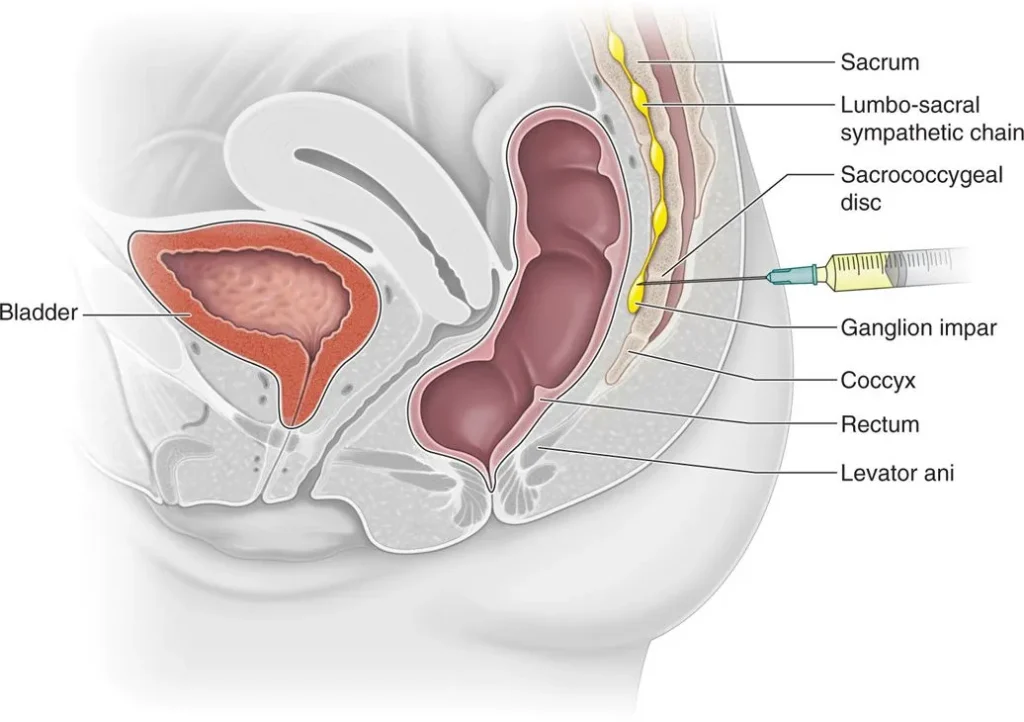
At Red Butte Pain Solutions, we frequently work alongside exceptional oncologists from across the Phoenix area to help patients manage cancer-related pain. Among the many types of pain experienced by cancer patients, coccyx (tailbone) and buttock pain are relatively common. These symptoms often indicate underlying pelvic cancers such as anal cancer, colorectal cancer, cervical cancer, prostate cancer, or even metastatic breast cancer. Let’s dive into the causes, symptoms, and treatment options for managing coccyx and buttock pain in cancer patients.
Recognizing Cancer-Related Coccyx and Buttock Pain
Cancer-related coccyx and buttock pain often stems from tumors in the pelvic region or metastases affecting surrounding nerves, tissues, or bones. The pain can be multifaceted and severe, sometimes interfering with daily activities and mobility.
- Persistent dull aches localized in the tailbone or buttocks. This type of pain may feel like a deep, constant soreness that worsens with prolonged sitting or standing. Patients often describe the sensation as a weight pressing on the coccyx or a heavy ache radiating through the buttocks, which can interfere with daily activities like walking, sitting, or working.
- Sharp, shooting pain radiating to nearby areas like the thighs, lower back, or hips. This type of pain can intensify with movement, sitting, or even lying down for extended periods, often disrupting sleep and daily activities. Such pain is commonly linked to nerve compression or irritation caused by cancer growth or metastasis in the pelvic region.
- Increased pain with sitting or movement due to pressure on the coccyx. This pain can become debilitating, as prolonged sitting exacerbates the discomfort. Often described as sharp or aching, it may radiate to surrounding areas, making daily tasks like driving or working at a desk challenging. In severe cases, even slight shifts in position can trigger intense pain, significantly impacting quality of life.
- Neuropathic pain, characterized by burning, tingling, or electric shock-like sensations, often results from cancer pressing on or infiltrating nearby nerves. This type of pain can also occur due to treatments like chemotherapy, which may damage nerve fibers and lead to ongoing discomfort.
- Loss of function or mobility issues in severe cases. This can include difficulty standing, walking, or performing everyday activities due to pain or physical impairment. Such issues may arise when tumors press against critical structures in the pelvis, leading to nerve damage or structural instability. In extreme cases, these symptoms can profoundly impact a patient’s independence and overall quality of life.
Coccyx Pain Symptoms As An Early Warning
Recognizing these symptoms is vital because they may serve as early warning signs of underlying cancers, such as:
- Anal cancer: Causes localized pain, rectal bleeding, and bowel movement changes. Pain from anal cancer often intensifies with sitting and may radiate into the perineal area. Additionally, patients may experience a sensation of fullness or difficulty with bowel movements due to tumor growth.
- Colorectal cancer: Presents with abdominal discomfort and referred pain in the lower pelvis. This pain can worsen during bowel movements or persist as a deep, aching sensation. Advanced cases may cause obstruction, leading to severe cramping or sharp pains.
- Cervical cancer: Leads to pelvic pain radiating to the buttocks. Pain from cervical cancer is often accompanied by abnormal bleeding, such as post-coital bleeding, and may become more pronounced as the disease progresses. The pain may extend into the lower back or thighs due to nerve involvement.
- Prostate cancer: Often causes deep pelvic pain that spreads to the coccyx. This pain may increase during urination or ejaculation and is often associated with urinary symptoms such as frequency or difficulty starting the stream. In advanced stages, metastasis to nearby bones can cause persistent, severe discomfort.
- Metastatic breast cancer: Can spread to pelvic bones, triggering severe pain. This pain is frequently described as sharp or throbbing and can worsen at night or with activity. Metastatic involvement often weakens bones, increasing the risk of fractures and further complicating pain management.
If you or a loved one experience these symptoms, seeking immediate medical evaluation is essential.
Diagnosing Coccyx and Buttock Pain from Cancer
Accurate diagnosis is essential for determining the underlying cause of coccyx and buttock pain and developing an effective treatment plan. The diagnostic process typically includes several critical steps:
- Detailed medical history and symptom review: Physicians will assess the patient’s medical background, cancer history, and specific pain characteristics, such as duration, intensity, and triggers.
- Physical examination: A thorough examination helps identify pain sources, check for tenderness or swelling, and evaluate the range of motion in the affected areas.
- Imaging studies: Advanced imaging techniques such as X-rays, CT scans, or MRIs are used to detect tumors, bone metastases, or structural damage in the pelvic region and coccyx.
- Biopsies: When cancer is suspected or needs confirmation, a tissue biopsy may be performed to identify the type and stage of the cancer.
- Nerve studies: These tests help assess the extent of nerve involvement, particularly if the pain is neuropathic, caused by compression or infiltration of nerves by cancerous growths.
Each diagnostic method contributes valuable insights, allowing for a comprehensive understanding of the pain’s origin and ensuring targeted, effective interventions.
Advanced Treatment Options for Cancer-Related Coccyx and Buttock Pain
At Red Butte Pain Solutions, we offer several advanced treatment options to alleviate cancer-related coccyx and buttock pain. Our multidisciplinary approach focuses on improving your quality of life while supporting your cancer care plan.
Medications and Adjunct Therapies
Analgesics: Include NSAIDs, opioids, or acetaminophen for pain control. These medications can help reduce both mild and severe pain, providing essential relief to support daily activities. Combining different types of analgesics may be necessary for more effective pain management in cancer patients.
Neuropathic pain medications: Gabapentin or pregabalin are commonly prescribed to manage nerve-related pain. These medications work by stabilizing nerve activity, which can alleviate burning, tingling, or electric shock-like sensations caused by nerve involvement or damage. Adjusting dosages and timing is key to optimizing their benefits while minimizing side effects.
Adjuvant therapies: Physical therapy and counseling play vital roles in comprehensive pain management. Physical therapy can improve mobility, reduce stiffness, and enhance overall function, while counseling provides emotional support and coping strategies. Together, these therapies can significantly improve a patient’s quality of life and help them navigate the challenges of cancer-related pain.
Ganglion of Impar Blocks and Neurolysis

The ganglion of Impar is a small but critical nerve cluster situated near the coccyx. It plays a central role in transmitting pain signals from the pelvic region and tailbone. For patients experiencing severe coccyx or buttock pain due to cancer, targeting this nerve cluster can provide significant relief.
Ganglion of Impar block involves injecting a local anesthetic, often combined with steroids, to disrupt pain signals temporarily. This minimally invasive procedure can help reduce inflammation and provide immediate, albeit short-term, pain relief. It is particularly useful for patients who need pain control to proceed with other cancer treatments or improve daily functioning.
Neurolysis, on the other hand, is a longer-lasting solution. This procedure uses alcohol or phenol to destroy nerve fibers within the ganglion of Impar. By eliminating the transmission of pain signals, neurolysis offers enduring relief, making it a preferred choice for patients with chronic or treatment-resistant cancer pain.
The benefits of these interventions are immense. Patients often experience a marked reduction in pain severity, enabling them to regain mobility and participate more fully in daily activities. Furthermore, these treatments can enhance tolerance to oncologic therapies by alleviating pain and improving overall comfort.
Hypogastric Plexus Blocks and Neurolysis
The hypogastric plexus is a complex network of nerves situated deep within the pelvis, playing a key role in transmitting pain signals from various pelvic organs and structures. For individuals experiencing severe or chronic pelvic pain due to cancer, targeting the hypogastric plexus can offer profound relief.
Hypogastric plexus block involves the injection of a local anesthetic, sometimes combined with steroids, to temporarily block pain signals traveling through these nerves. This minimally invasive procedure is often used to manage acute pain flare-ups or to provide short-term relief, enabling patients to tolerate other treatments or resume daily activities.
Neurolysis is a more durable intervention that uses chemical agents like alcohol or phenol to disrupt the function of the hypogastric plexus permanently. This approach is particularly beneficial for patients with advanced cancer experiencing refractory pain, offering significant, long-term relief when other treatments have proven insufficient.
These procedures are especially effective for managing pain caused by pelvic cancers, including prostate, colorectal, and cervical cancers. By targeting the specific nerve pathways responsible for transmitting pain, hypogastric plexus blocks and neurolysis not only reduce pain intensity but also enhance overall quality of life by improving mobility, comfort, and emotional well-being.
Integrative Approaches
Infusion therapies: Lidocaine and ketamine infusions are advanced options that can significantly reduce nerve pain. These treatments work by interrupting pain signals, providing relief even for patients with severe or refractory pain. Lidocaine infusions are particularly beneficial for neuropathic pain, while ketamine infusions offer additional benefits for patients dealing with chronic pain syndromes linked to cancer.
Lifestyle modifications: Simple changes can greatly support overall health and pain management. Proper ergonomic seating reduces strain on the coccyx and pelvis, while gentle exercises, such as yoga or swimming, enhance mobility and alleviate stiffness. Dietary adjustments, including anti-inflammatory foods like omega-3-rich fish or leafy greens, can support overall wellness and potentially reduce pain levels.
Taking the Next Steps
Advanced treatments like ganglion of impar blocks and hypogastric plexus neurolysis can transform the lives of patients suffering from cancer-related coccyx or buttock pain. At Red Butte Pain Solutions, our team works closely with cancer pain experts and your broader care team to provide a comprehensive, compassionate approach to treatment.
We deliver targeted therapies that not only relieve pain but also improve your quality of life.
📞 Call us at 602-633-4334
🔗 Schedule your appointment and take the next step toward relief.
We proudly serve patients from Chandler, Ahwatukee, Laveen, Sun Lakes, Casa Grande, Maricopa, Gilbert, Mesa, Tempe, and South Phoenix.
